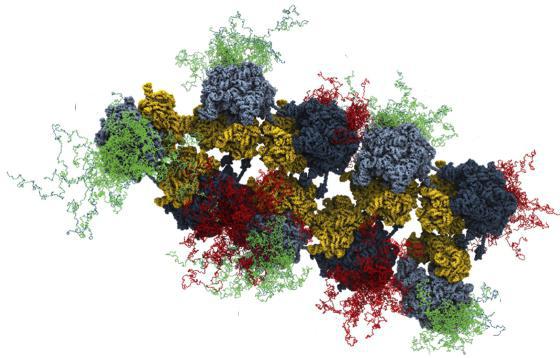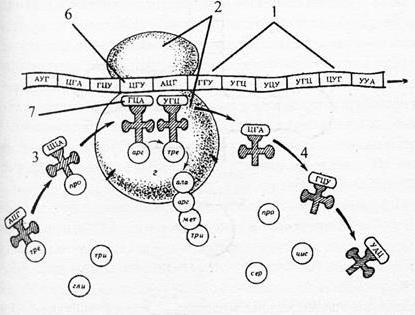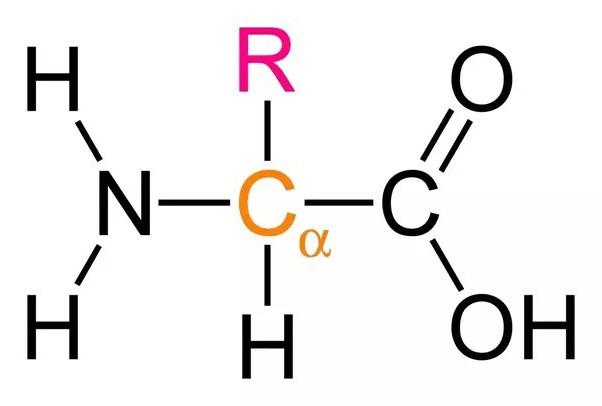What is a polysome. The structure of the polysome prokaryotes and eukaryotes
Protein synthesis is a vital biologicala process that is observed in the cells of any organism. Proteins, as the main class of organic substances of cells, perform a wide range of functions, starting from enzymatic and ending with protective. What is a polysome? How is this structure used in protein synthesis?
What is a polysome
In cells of eukaryotes and prokaryotes, compulsorystructures are ribosomes. These are small bodies consisting of two subunits and performing the function of protein synthesis during translation. Ribosomes are non-membrane structures.
The polysome is an education consisting ofseveral ribosomes. They are linked together by means of a matrix or information RNA. Several ribosomes, like beads, are attached to this molecule, resulting in a temporary structure - the polysome.
Cell polysomes concentrate where fast synthesis of a large number of proteins is necessary. This is the main biological role of these formations.

Structure of the ribosome
Since a polysome is formed by several ribosomes interconnected among themselves, it is necessary to consider the structure of the latter.
Any cell ribosome consists of two subunits: large and small. A small gap is formed between them, which is exactly the same diameter for the mRNA molecule, which should be there.
Ribosomes are complexnucleoprotein complexes, since molecules of ribosomal RNA and proteins are part of both small and large subunits. Proteins act as a framework, and RNAs that have ribozyme (enzymatic) activity are used in the translation process.

Differences between ribosomes of prokaryotes and eukaryotes
Because prokaryotes and eukaryotes are two different groups of organisms, they have differences in the composition of the ribosomes, and hence the polis too.
Prokaryotes in the cytoplasm have a largethe amount of 70S of ribosomes (S is the sedimentation constant, which shows the particle settling rate in the centrifuge). They are formed by a large 50S subunit and a small 30S subunit. The large subunit of prokaryotes includes 5S and 23S RNA. In turn, a small subunit is formed by 16S RNA.
In bacterial cells a lot of polis is formed. This is due to the fact that they have a very fast process of protein synthesis: translation begins even before the transcription process ends. For the same reason, the concentration of ribosomes in the cell is the largest near the nucleoid.
In eukaryotes there are differences in valuesthe sedimentation constants of the ribosome elements. For her, this value is 80, for large and small subunits - 60 and 40, respectively. In the large subunit, 5S, 28S and 5.8S RNA are isolated, and in small - 18S RNA.
In both prokaryotes and eukaryotes, polysomes accelerateprocess of protein synthesis. This is very important when rapid copies of protein molecules are necessary. The high rate of synthesis is especially characteristic for bacteria, since their matrix RNA exists for a short time, and during this interval it is necessary to synthesize as many protein molecules as possible. That's what polysomes in biology are.

The translation process is the main function of the polysome
In the process of translation, the primary structure of the protein molecule is formed. There are three stages of polypeptide synthesis: initiation, elongation and termination.
1. Initiation of the broadcast. The mRNA molecule must attach to 16S RNA on the principle of complementarity. For this, there is a special sequence, which in prokaryotes is called a ribosomal binding site, and in eukaryotes - by a cap. Consequently, the information RNA is attached to the small subunit of the ribosome.
2. Elongation. This stage is characterized by the build-up of the polypeptide chain. Transport RNAs bring to the ribosome amino acids that are attached to the resulting chain via a peptide bond. Thus, protein synthesis passes until the moment when the ribosome does not stumble onto the stop codon.
3. Termination. After she reached the stop codon, protein synthesis ceases. The newly formed molecule of the polypeptide falls out of the ribosome through a special course, and then the secondary, tertiary or quaternary structure is formed.

Ribosomal profiling - method of studying ribosomes
To study what a polysome is, you needisolate this structure from the body cells. The easiest way to do research on prokaryotic cells. Ribosomal profiling includes the following stages:
1. Destruction of the prokaryotic cell. It is important that the destruction must be carried out mechanically, since chemical substances can damage the ribosomes themselves.
2. RNA cleavage, which are not ribosomal.
3. The same principle removes unnecessary polypeptides that are not part of the structure.
4. Reverse transcription of the isolated ribosomal RNA.
5. Sequencing of the obtained DNA.
Conclusion
The polysome is a structure that is formed fromseveral ribosomes. Its task is to accelerate the synthesis of proteins. These structures are found in cells of prokaryotes and eukaryotes, therefore they are characteristic for cells of any organism. That's what polisomes are.







